Talking Plants: Plant Science Communication in a Digital World with Claire Hopkins
Talking Plants: Plant Science Communication in a Digital World
Recorded May 2017
About This Webinar:
In this seminar, Claire Hopkins will cover the basics, challenges, and joys of communicating plant science to the public. She will offer simple tips for improving your communication skills in any setting while explaining the advantages of various methods and digital platforms. She will cover aspects of content creation, including equipment, audience, language, and strategy.
Participants will be able to:
- Communicate plant science to the public more succinctly and effectively
- Understand the techniques and challenges of using video for science communication
- Choose a platform or method of science communication that best suits their
SPEAKER
 Claire Hopkins, Science Educator
Claire Hopkins, Science Educator
Claire is the Content and Community Manager at Brilliant Botany and a freelance science educator. She received her bachelor’s degree in plant biology and English from the University of Vermont and has worked extensively in museums and herbarium collections. Claire is passionate about using digital media to build community and make science engaging and accessible, with a particular focus on reaching underserved populations, such as women and minorities. She creates content on YouTube and Tumblr, and she hosts live science programs at festivals, expos, and libraries. Her favorite botanical topics include pollination, horticulture, and plant systematics.
This webinar is free is freely available thanks to the support of the American Society of Plant Biologists
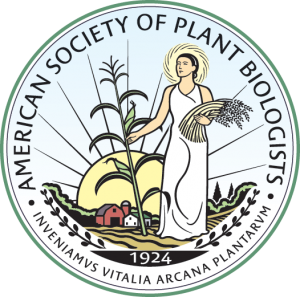
If you would like to sponsor an upcoming webinar please contact [email protected]


 Glucosinolates are sulfur-containing defense compounds produced by brassica plants. Brassica napus (canola) is an important oilseed crop because a low-glucosinolate variety has been developed. Brassica juncea is more stress tolerant, but has not been developed as a crop due to its high levels of glucosinolates. In a “transport engineering” approach, Nour-Eldin et al. identified glucosinolate transport proteins highly expressed in seeds, and then found loss-of-function mutants in these genes. Production of double, triple and quadruple mutants led to a significant reduction of seed glucosinolate production, although not yet to the point needed for commercial use. Nature Biotech.
Glucosinolates are sulfur-containing defense compounds produced by brassica plants. Brassica napus (canola) is an important oilseed crop because a low-glucosinolate variety has been developed. Brassica juncea is more stress tolerant, but has not been developed as a crop due to its high levels of glucosinolates. In a “transport engineering” approach, Nour-Eldin et al. identified glucosinolate transport proteins highly expressed in seeds, and then found loss-of-function mutants in these genes. Production of double, triple and quadruple mutants led to a significant reduction of seed glucosinolate production, although not yet to the point needed for commercial use. Nature Biotech.  Plant reproduction is particularly sensitive to heat stress, so rising temperature is a major threat to food security. Zhang et al. surveyed the transcriptional responses to heat stress (3 h at 37º) in Arabidopsis and identified large differences between vegetative and reproductive tissue responses to heat. In reproductive tissue, heat-responsive genes include those participating in the unfolded protein response (UPR), a eukaryote-wide signalling pathway in which unfolded proteins in the ER initiate signals that are transduced to the nucleus and lead to the expression of stress-response genes. bZIP28 and bZIP60 are two key transcription factors involved in the UPR, and bZIP28 / bZIP60 double mutants are particularly vulnerable to heat stress, demonstrating that the UPR protects reproductive development during heat stress. Plant Cell
Plant reproduction is particularly sensitive to heat stress, so rising temperature is a major threat to food security. Zhang et al. surveyed the transcriptional responses to heat stress (3 h at 37º) in Arabidopsis and identified large differences between vegetative and reproductive tissue responses to heat. In reproductive tissue, heat-responsive genes include those participating in the unfolded protein response (UPR), a eukaryote-wide signalling pathway in which unfolded proteins in the ER initiate signals that are transduced to the nucleus and lead to the expression of stress-response genes. bZIP28 and bZIP60 are two key transcription factors involved in the UPR, and bZIP28 / bZIP60 double mutants are particularly vulnerable to heat stress, demonstrating that the UPR protects reproductive development during heat stress. Plant Cell 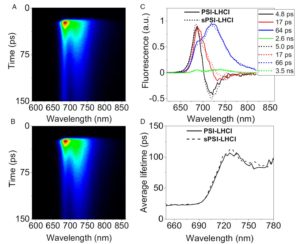 Photosynthesis in plants involves two photosystems acting in series, Photosystem I (PSI) and PSII. Each photosystem is a massive complex consisting of numerous proteins and pigments. The photosystems are efficient at light harvesting but also sensitive to high-light induced photooxidative damage. Photosynthetic organisms have several ways to protect against high-light damage, one of which is a form of non-photochemical quenching (NPQ) that occurs when zeaxanthin is produced from violaxanthin. Zeaxanthin-dependent NPQ was associated solely with PSII, until a recent study of a zeaxanthin over-expressing mutant indicated that it also contributes quenching to PSI. However, here Tian et al. show that in biologically relevant conditions zeaxanthin does not lead to PSI quenching. Proc. Natl. Acad. Sci. USA
Photosynthesis in plants involves two photosystems acting in series, Photosystem I (PSI) and PSII. Each photosystem is a massive complex consisting of numerous proteins and pigments. The photosystems are efficient at light harvesting but also sensitive to high-light induced photooxidative damage. Photosynthetic organisms have several ways to protect against high-light damage, one of which is a form of non-photochemical quenching (NPQ) that occurs when zeaxanthin is produced from violaxanthin. Zeaxanthin-dependent NPQ was associated solely with PSII, until a recent study of a zeaxanthin over-expressing mutant indicated that it also contributes quenching to PSI. However, here Tian et al. show that in biologically relevant conditions zeaxanthin does not lead to PSI quenching. Proc. Natl. Acad. Sci. USA 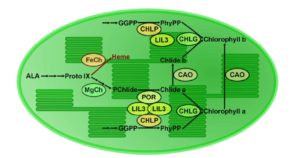 The final step in the synthesis of chlorophyll is the joining of chlorophyllide, (a tetrapyrrole with planar structure similar to heme) to a linear lipid (a product of the terpenoid pathway) that provides an attachment point for the resulting chlorophyll to pigment-binding proteins of the light-harvesting complexes. LIL3 (Light-harvesting-Like) is a membrane-spanning protein that was previously shown to interact with geranylgeranylreductase (CHLP), an enzyme involved in terpene biosynthesis. Hey et al. show that LIL3 also interacts with protochlorophyllide oxidoreductase (POR), the enzyme that catalyzes chlorophyllide production, as well as its substrate, protochlorophyllide. The authors suggest that through these interactions, LIL3 may serve to coordinate the production of the two intermediates required for chlorophyll production. Plant Physiol.
The final step in the synthesis of chlorophyll is the joining of chlorophyllide, (a tetrapyrrole with planar structure similar to heme) to a linear lipid (a product of the terpenoid pathway) that provides an attachment point for the resulting chlorophyll to pigment-binding proteins of the light-harvesting complexes. LIL3 (Light-harvesting-Like) is a membrane-spanning protein that was previously shown to interact with geranylgeranylreductase (CHLP), an enzyme involved in terpene biosynthesis. Hey et al. show that LIL3 also interacts with protochlorophyllide oxidoreductase (POR), the enzyme that catalyzes chlorophyllide production, as well as its substrate, protochlorophyllide. The authors suggest that through these interactions, LIL3 may serve to coordinate the production of the two intermediates required for chlorophyll production. Plant Physiol. 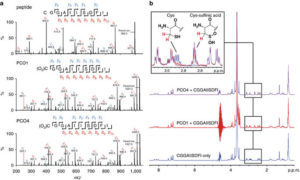 Flooding “drowns” plants by depriving them of oxygen, leading to hypoxia and ultimately death. Ethylene-responsive transcription factors (ERFs) have been identified that induce expression of genes to support anaerobic metabolism and are critical for hypoxia survival. ERFs are selectively destabilized in normal oxygen environment (normoxia), through a turnover response known as the N-end rule pathway, in which their N-terminal methionine is removed to expose a cysteine that is susceptible to oxidation, triggering a proteolytic turnover process. White et al. show the first direct biochemical evidence for the formation of Cys-sulfinic acid (CysO2) by PLANT CYSTEINE OXIDASEs (PCOs) and that this reaction involves the incorporation of molecular oxygen (O2). Furthermore, the authors show that CysO2 is a direct substrate for arginylation by ARGINYLTRANSFERASE 1 (ATE1) which is the entry point to proteolytic degradation in vivo. These findings may lead to the development of plants with improved flooding tolerance. Nature Comms.
Flooding “drowns” plants by depriving them of oxygen, leading to hypoxia and ultimately death. Ethylene-responsive transcription factors (ERFs) have been identified that induce expression of genes to support anaerobic metabolism and are critical for hypoxia survival. ERFs are selectively destabilized in normal oxygen environment (normoxia), through a turnover response known as the N-end rule pathway, in which their N-terminal methionine is removed to expose a cysteine that is susceptible to oxidation, triggering a proteolytic turnover process. White et al. show the first direct biochemical evidence for the formation of Cys-sulfinic acid (CysO2) by PLANT CYSTEINE OXIDASEs (PCOs) and that this reaction involves the incorporation of molecular oxygen (O2). Furthermore, the authors show that CysO2 is a direct substrate for arginylation by ARGINYLTRANSFERASE 1 (ATE1) which is the entry point to proteolytic degradation in vivo. These findings may lead to the development of plants with improved flooding tolerance. Nature Comms. 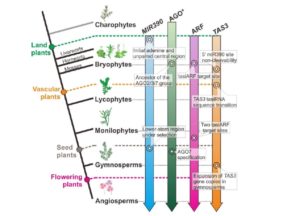 Trans-acting small interfering RNAs (tasiRNAs) are unique to plants. They are the products of TAS genes, but they function to regulate other genes (thus the name “trans-acting”). The production of tasiRNAs requires miRNAs, which bind to and ultimately lead to cleavage of the primary TAS transcript. TAS3 is the best studied TAS gene. Its production depends on miR390, and its tasiRNA products target AUXIN RESPONSIVE FACTOR (ARF) genes. Xia et al. characterized genes corresponding to the miR390-TAS3-ARF pathway in thousands of plant species to uncover their evolutionary trajectories. Their data “illuminate the evolutionary path of the miR390-TAS3-ARF pathway in land plants, and demonstrate the significant variation that occurs in this functionally important and archetypal regulatory circuit.” Plant Cell
Trans-acting small interfering RNAs (tasiRNAs) are unique to plants. They are the products of TAS genes, but they function to regulate other genes (thus the name “trans-acting”). The production of tasiRNAs requires miRNAs, which bind to and ultimately lead to cleavage of the primary TAS transcript. TAS3 is the best studied TAS gene. Its production depends on miR390, and its tasiRNA products target AUXIN RESPONSIVE FACTOR (ARF) genes. Xia et al. characterized genes corresponding to the miR390-TAS3-ARF pathway in thousands of plant species to uncover their evolutionary trajectories. Their data “illuminate the evolutionary path of the miR390-TAS3-ARF pathway in land plants, and demonstrate the significant variation that occurs in this functionally important and archetypal regulatory circuit.” Plant Cell 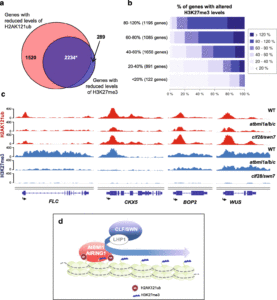 Gene silencing by chromatin marks occurs in plants and animals, but there are often some differences in the details. Polycomb repressive complex 1 (PRC1) and PRC2 were first characterized in animals and shown to repress gene expression in part through histone modification; PRC1 has histone H2A E3 ubiquitin ligase activity, and PRC2 has histone H3 lysine 27 (H3K27) tri-methyltransferase activity. In animals, the classic hierarchical model for Polycomb group (PcG) complex recruitment proposes that the H3K27me3 produced by PRC2 recruits PRC1, leading to H2A ubiquitination. Zhou and
Gene silencing by chromatin marks occurs in plants and animals, but there are often some differences in the details. Polycomb repressive complex 1 (PRC1) and PRC2 were first characterized in animals and shown to repress gene expression in part through histone modification; PRC1 has histone H2A E3 ubiquitin ligase activity, and PRC2 has histone H3 lysine 27 (H3K27) tri-methyltransferase activity. In animals, the classic hierarchical model for Polycomb group (PcG) complex recruitment proposes that the H3K27me3 produced by PRC2 recruits PRC1, leading to H2A ubiquitination. Zhou and